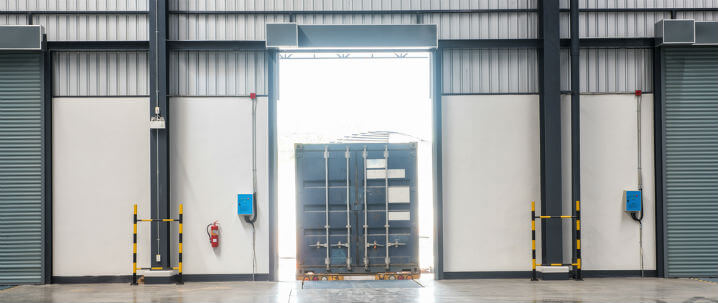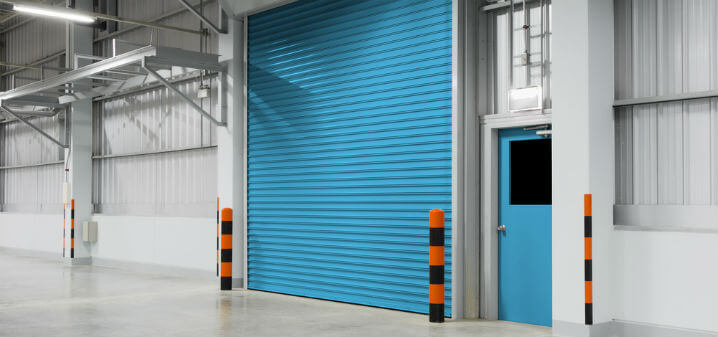Warehouses, factories, restaurants, hospitals, and other types of businesses typically have loading docks. These loading docks are essential to a reliable business supply chain. However, there are certain safety procedures that employees and employers must follow.
What Is a Loading Dock?
Loading docks are key logistical component for many businesses. The Bureau of Transportation Statistics reported in 2018, an estimated $19 trillion in goods or 18.6 billion tons were a part of the freight network that includes loading docks.
Warehouse docks are areas where delivery vehicles can pull up and unload. The docks are raised to a certain height to account for the height of cargo vehicles. While it is a common and essential part of business operations, loading docks also accounted for an estimated 6,000 employee injuries in 2018 per the Bureau of Transportation Statistics.
6 Common Loading Dock Safety Hazards
Loading dock safety seems simple, don’t fall off the edge. If an employee avoids doing this, everything seems to meet safety compliance regulations. The only problem is employers also must take steps to ensure the safety of employees in warehouse and on the loading dock. It’s not enough to let employees know not to fall off the edge, employers must help prevent it.

Some loading dock safety hazards are easy to envision, others aren’t as obvious.
- If the warehouse dock is slippery from moisture or oil it is a hazard to employees.
- Loose dock plates often result in slips and falls.
- Injuries from trailer wheels not properly chocked
- Illness due to carbon monoxide exposure from vehicle exhaust.
- Back injuries due to improper lifting and carrying of goods.
- Injuries from forklift falls.
Forklifts are common on loading docks and are responsible for some of the injuries that occur at the job site.
OSHA Loading Docks Requirements
The following loading dock safety guide will guide employers through the necessary safety steps. Some tips are simple, such as installing loading dock protective barriers, while others are more complicated. For example, what if the loading dock doesn’t meet OSHA code requirements for height or safety?
The height of the warehouse dock and accompanying loading dock safety barriers aren’t the only safety aspects OSHA looks for, clear vision from all angles on the loading dock is also vital for safety. A company’s loading dock should also be visible, which is why yellow stripes at the edge are common. The bright color helps ensure employees are visible and drivers can see the loading dock.

5 Loading Dock Safety Tips
OSHA loading dock fall protection includes safety tips that will prevent incidents.
1. Forklift Safety
It is easy to misgauge the distance from the loading dock edge in a forklift. Yellow lines at the dock’s edge will help prevent forklifts from falling off docks. There are also other steps businesses can take to ensure forklifts don’t go over the dock’s edge.
Protective barriers around loading docks, such as chains or bars can prevent forklifts from tipping over the side. When it comes to driving a forklift on a flatbed trailer, OSHA recommends only doing so when there isn’t a gap in height or distance. If the tailer is flush against the loading dock, a forklift can safely load and unload the product.
Safety By Design offers OSHA-aligned forklift training in Houston. Contact us for more information on our program availability.
2. OSHA Compliant Dock Barriers
A company’s loading dock safety checklist must include safety barriers. According to OSHA standard 29 CFR 1910.28(b)(1)(i), a dock that creates a drop of four feet or more must be guarded with a barrier.
Chains are one-way employers can create a barrier, but bars are often recommended. Bars often have less give than chains and can prevent a forklift or individual from falling off the loading dock.
3. Limit Vehicle and Pedestrian Traffic
Before loading or unloading begins, loading bay requirements state that all unnecessary employees vacate the area. Minimizing both pedestrian and vehicular traffic will cut down on the number of loading dock incident reports.
4. Keep the Loading Dock Clean
Loading docks, whether at warehouses or other businesses are susceptible to the weather. Leaves and other debris should be regularly swept away. Water can also collect, resulting in dangerous working conditions.
Oil from forklifts can also cause employees to slip and fall. Forklifts can also experience problems with slick loading dock floors. Loading dock code requirements state that the floors must be clear of debris and moisture, along with oil.
See our related resources for more information on warehouse safety training for your team.
5. Ensure Trailer Safety
Loading dock fall protection requirements include safety when employees are handling the loading or unloading of a trailer. Ensure the vehicle is parked close to the loading dock.
Ventilation is also key. OSHA loading docks requirements state that employers must ensure proper ventilation to prevent overexposure to carbon monoxide. The poisonous gas is emitted from vehicle exhaust and is fatal if inhaled over prolonged periods.
Safety By Design Offers Comprehensive Safety Consulting
Loading dock safety is more than installing protective barriers. It also requires planning and OSHA-related safety training courses. If your business needs loading dock safety tips or help creating a safe work environment, the safety consultants at Safety By Design can help!
Contact Safety By Design today to schedule a consultation for your occupational safety.



